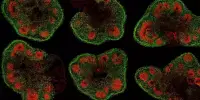The sounds babies make in their first year of life may be less random than previously thought, according to a language development researcher at The University of Texas at Dallas. Dr. Pumpki Lei Su, an assistant professor of speech, language, and hearing at the School of Behavioral and Brain Sciences, co-authored two recent studies in which researchers investigated the sounds that babies make. The findings show that children in their first year are more active in speech acquisition than previously considered.
“We observed in these studies that infant vocalizations are not produced randomly; they form a pattern, producing three categories of sounds in clusters,” said Su, who also directs the Callier Center for Communication Disorders’ Language Interaction and Language Acquisition in Children Lab (LILAC Lab). “The home recordings we analyzed included times when adults were interacting with their child and when children were on their own, showing that children explore their vocal capabilities with or without language input from an adult.”
Parents tell us that sometimes a baby will just scream or make low-frequency sounds for a really long period. But it’s never been studied empirically. With access to a huge dataset from hundreds of children during the first 12 months of their lives, we set out to quantitatively document how babies explore and cluster patterns as they practice different sound categories.
Dr. Pumpki Lei Su
The first study, published in PLOS ONE, focused on usually developing children, whereas the second, published in the Journal of Autism and Developmental Disorders, focused on infants who later got a confirmed autism diagnosis. The researchers observed how children “play” verbally, learning which activities make specific sounds and then repeating the procedure.
Within the past 40 to 50 years, scientists have realized that vocalizations before a child’s first word are meaningful precursors for speech and can be broken into sequential stages of cooing, vocal play, and babbling. Su’s team studied a dataset of all-day home recordings from more than 300 children amassed by the Marcus Autism Center, a subsidiary of Children’s Healthcare of Atlanta, and coded by senior author Dr. D. Kimbrough Oller’s team at The University of Memphis.
“Parents tell us that sometimes a baby will just scream or make low-frequency sounds for a really long period. But it’s never been studied empirically,” Su said. “With access to a huge dataset from hundreds of children during the first 12 months of their lives, we set out to quantitatively document how babies explore and cluster patterns as they practice different sound categories.”

Squeals, growls, and vowelling noises are examples of sound types distinguished by pitch and frequency. The PLOS ONE study included almost 15,000 recordings from 130 typically developing children in its dataset. Infants exhibited substantial clustering patterns: 40% of recordings contained significantly more squeals than expected by chance, while 39% contained clustered growls. Clustering was widespread at all ages, with the highest rates observed after 5 months of age.
“Of the 130 infants, 87% showed at least one age at which their recordings showed significant squeal clustering and at least one age with significant growl clustering,” Su told me. “There was not a single infant who, on evaluation of all the available recordings, showed neither significant squeal nor growl clustering.”
Su said the study represents the first large-scale empirical study investigating the nonrandom occurrence of the three main sound types in infancy. In the Journal of Autism and Developmental Disorders article, Su and her colleagues demonstrated that this exploration behavior also occurs during the first year in children who are later diagnosed with autism spectrum disorder.
“Whether or not a child is eventually diagnosed with autism, they are clustering sounds within one vocal category at a time,” Su said. “While one cannot rule out the possibility that some patterns may be mimicry, these are not just imitations; they are doing this with and without the presence of a parent, even in the first month of life. This process of learning to produce sounds is more endogenous, more spontaneous than previously understood.
“We tend to think babies are passive recipients of input. And certainly, parents are their best teachers. But at the same time, they’re doing a lot of things on their own.”
Su has received a three-year grant from the National Institute on Deafness and Other Communication Disorders (NIDCD) to study parents’ use of “parentese” – or baby talk – with autistic children. Parentese is an exaggerated style of speech often containing high-pitched elongated words and singsong diction.
Parentese is portrayed in the literature as a sort of ideal input for usually developing youngsters, who pay more attention and respond to it than to ordinary speech. It also teaches children how to segment words. But is it also suitable for autistic children?
“One hypothesis of why parentese works is that it encourages social interaction by being very animated,” Su told me. “Autistic children exhibit variances in social communication and sensory reactions. Would they also find parentese interesting? Could it be overly loud or extreme? This new grant will allow me to investigate if parentese improves word learning for autistic children when compared to a more traditional adult-directed register.”
















